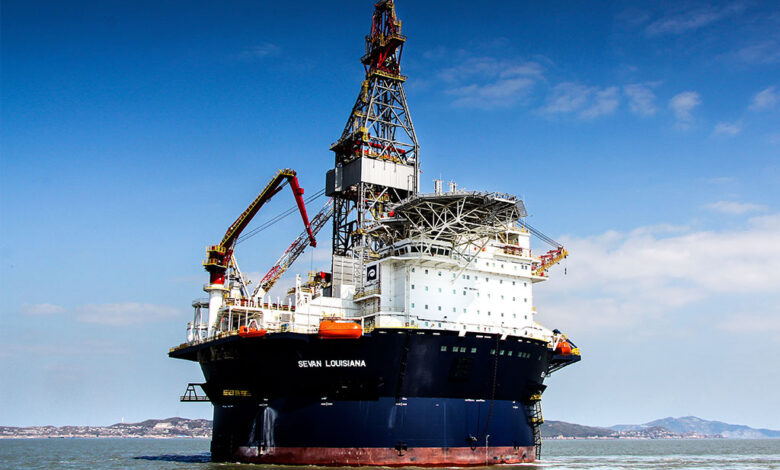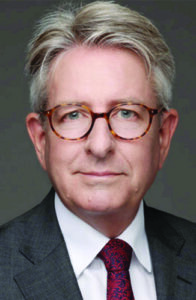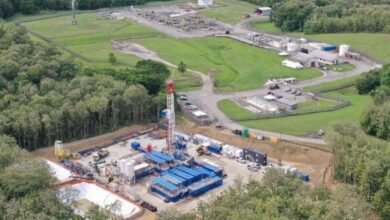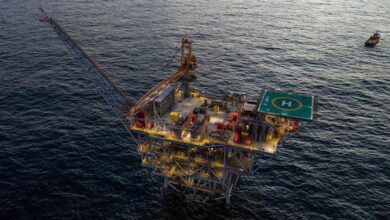Industry consolidation could shift offshore rig supply/demand, trigger transformation in business model

Seadrill’s Stuart Jackson: Addressing market imbalance can encourage operators to give drillers more revenue visibility, lead to more investments in rigs, ESG
By Stephen Whitfield, Associate Editor
Stuart Jackson is CEO of Seadrill.
The past year has been difficult for drilling contractors, to say the least. How would you gauge global market sentiment within the industry right now?

It’s a tough market. We’ve got the ongoing operational issue of COVID-19 – the practical aspects of keeping a business running, the logistics of getting people on and off rigs, and making sure they quarantine and meet testing requirements. All of that adds more difficulty to day-to-day operations. And then you need to overlay the market itself, which is tough when you talk about new business. I don’t think we’ve seen any improvement coming into 2021. You’ve got a lot of financial restructuring going on. A number of companies are in Chapter 11.
If I squint very hard, I might think there’s something there, but honestly, you’re probably looking at another 12 months until we start to see tender activity come through to generate increased utilization.
Cold stacking has been a lever that many drillers have pulled to help stay afloat during the downturn. Do you think this will continue to be a favorable option in the near term? From a financial perspective, does it make more sense to scrap assets altogether rather than cold-stack them?
With this question, I have the benefit of coming from outside the drilling sector. I always thought that drillers liked to maintain their options as long as they can, and the consequence of that is they would rather cold-stack assets as opposed to scrapping them. Having been at Seadrill for 18 months now and looking at the number of assets we’ve had cold-stacked, I can see the investment I have in front of me, both in terms of the cash I need to outlay before they can get back into the market and the cost it will take to reactivate them.
For Seadrill alone, this is probably in the region of $1.5 billion in total over a number of years for those assets to be working again. When you’re doing restructuring with the banks, considering significant write-down of their debt, it’s hard to think that there is also a need for $1.5 billion to get your assets back on the market and that the market will be there to sustain such investment. So, you need to take a very hard look at whether those assets are ever going to come back.
That’s why, when you look at our results in the first quarter of 2020, we took a $1.2 billion write-down of our assets. That’s on the back of taking a 50% write-off when we came out of Chapter 11 in 2018. These decisions were all aligned to a more probabilistic, market and operational driven approach toward scrapping. That’s why we have 10 rigs sitting on the blocks being prepared to be scrapped.
I lean far more toward getting the assets out of the market now if you can’t really see a good opportunity for them in the short term. If you’re bridging to a stronger market, cold-stacking should be an option, but you can’t cold-stack assets for five years hoping they’ll come back again with any real confidence.
How much value do you think a younger rig fleet could provide for Seadrill or any other contractor, especially once we start to see a recovery in the market?
We’ve always led with having one of the youngest fleets, but it’s a relative term because everyone’s fleet gets older. The silver lining of the current market is that it will be a long time before we see newbuild orders. In terms of what it means when operators are looking at tenders, it definitely has an impact. The more important aspect with operators is whether you’re continuing to reinvest in your assets, particularly around the environmental aspects of ESG. Are you changing your asset profile to help operators in terms of the emissions targets they’ve placed upon themselves? Those types of impacts, to me, are becoming more significant than the actual age of the underlying asset itself.

How can drilling contractors adapt to a lower-carbon future?
We’ve already adopted different technologies on some of our assets to help in that respect. You look at the work we did in terms of putting hybrid power on the Mira rig, that’s giving us the opportunity for significant reductions in our footprint around NOx, SOx and CO2. It helps operators achieve their emissions reduction targets. But really, it’s also the right thing for Seadrill to do, irrespective of the impact on the operator. We should be looking to play our part in the broader decarbonization of our planet.
Once the restructurings are out of the way and people have better balance sheets to plan against, we can all look to invest a bit more in terms of the technological and innovation aspects of the business, particularly where they have an environmental impact. I think we’re in the early stages of this journey, and it’s something everybody’s going to have to adapt to. I also believe it is something drilling contractors and operators need to address jointly, so as to maintain momentum and not simply argue about the relative costs and benefits.
What have been some of the biggest challenges to maintaining health and safety protocols on the rig during the COVID-19 pandemic?
For one, there’s the practical aspect of how to get a person from A to B when the airplanes aren’t flying. It required more coordination between drillers and offshore service providers. That also leads to longer hitches for people on the rigs, particularly early on when those logistics weren’t as well set up as they are now. We’ve had people on rigs for a number of months, perhaps three or four months before they were able to travel home. That’s something we’ve kept a very close focus on, managing that aggregate number down as quickly as we could. We’re fortunate to have gotten that number down to very low levels, but there are still people on longer-term hitches.
The other aspect is not just physical but rather the mental health attached to the people who are on the rigs for a protracted period of time, away from their families, concerned about their families back at home and what’s going on in their home countries. That obviously has an onshore perspective, too. We’ve been focused on making sure that people reach out and talk to each other, and maintain communication just in terms of day-to-day dialogue.
We have relied a lot upon the flexibility of our employees being able to accommodate the requirements of the business. I’ve consistently been surprised to how far people will go to make sure that they’re doing all they can to maintain our operations.
What are some of the best ways that drilling contractors can improve the efficiency of their rigs?
This is allied to what we do in terms of ESG, so we’ve been very focused on improving fuel efficiency and reducing emissions. Not only have we monitored our own activity over a number of years in that respect, but we’ve participated in the Carbon Disclosure Project since 2012. That has allowed us to benchmark our performance against the industry’s.
From a drilling performance perspective, that’s a question we’re always asking. How can we be a more effective driller for the operators? They have a business model that’s built around paying us on a dayrate basis, so our competitiveness has to come through stringent cost control and an ability to deliver safe, efficient operations that allow our customers to reach and evaluate their targets more quickly.
Do you think the dayrate model is an optimal business model for the industry moving forward, or do you think the business model needs to evolve? If so, what would you like to see?
The answer to that depends on what side of the fence you’re sitting on. If you’re an operator, then the dayrate model is fine. You will have to bear the scars of paying high rates when the market is very high and assets are tight, but you do get the benefit of reducing your costs as the market starts to open up. And, of course, you control the time you contract.
From an offshore driller’s perspective, I very much think the model should change. We are making 30-year investment decisions on the basis of six or 12 months of revenue visibility. That’s not a great model. You have to look backwards in terms of our market to see that it’s cyclical and will always remain cyclical going forward, and it’s subject to significant changes in a very short period of time. That doesn’t help long-term investment decisions, especially when you overlay the drive from operators, for example, to help them in terms of their zero emissions targets. They’re asking us to do more investment on assets where we have limited visibility. So, the more that the operators can do in terms of providing security of revenue, the more we can do in terms of investing in assets for the long term to support their business.
I’m in the camp that believes, fundamentally, we need to change the business model and the way we interact with operators, but we need to find the trigger that allows them to take the same approach. That trigger may be industry consolidation – taking a dozen players down to three or four players and, therefore, changing fundamentally the supply/demand imbalance. The operators engage on this basis in other verticals of the hydrocarbon supply chain; currently they have the luxury of too many players in the offshore drilling sector.
Do you think performance-based contracts are a feasible solution for the industry to pursue?
You’ve got an element of that already in terms of bonuses being built into some of the contracts. Ultimately, when you have an environment like we work in – offshore, harsh environment, with very large machinery moving very quickly – speed and safety are competing priorities, and we want very much to maintain our focus on safe operations. Having an incentive mechanism around just completing things quicker does not, therefore, always lead to the right outcomes. We shouldn’t just be driving for quicker activity because that will unwind everything we’ve done in terms of building a safety-conscious environment over the last few decades.
How well do you think drilling contractors make use of the data at their disposal?
Up until now, I’d say we’ve been relatively poor in this arena. There’s a huge wealth of information sitting out there that we’re not yet applying as much as we could, but we’ve started down that journey at Seadrill. You look at something like the PLATO platform that’s enabling consistent monitoring and giving us a better idea of when we may need to replace parts and do maintenance or repair work in advance of failure.
In terms of the broader aspects, not just data management but the use of artificial intelligence, with the human-machine interface, we’ve already started with Vision IQ that uses LIDAR. The system continually scans the drill floor to ensure we know where our people are, relative to moving machinery and equipment. Vision IQ makes the drill floor a far safer environment for our people to work in. We will continue to invest in those aspects as we have done before, and I think innovation and technology have a far larger role to play in our business going forward.
Has the downturn had any impact on the development of digital and automated systems, or their adoption on the rig site?
It hasn’t had too much of an impact because there are projects we’ve had running for a few years, so they probably pre-date the discussion we’ve been having with the banks over the last few months. Also, some of these systems have been developed with a relatively small amount of money, so it’s not on the top of the list in terms of capital investment, especially compared with the physical maintenance of the rigs themselves. For instance, the PLATO platform was a relatively small cost, and we found an outside provider to partner with, so were able to develop, test and roll out despite the downturn.
Do you think standardization is something that can benefit Seadrill?
To a certain degree, we have standardization with the different pockets of assets we have. As we’ve gone through the build process, a lot of the new assets came from the same yard with the same specs and so forth. Where we’ve deviated from that model has been with our acquisitions. That has given us a mix of different assets. The challenge that the offshore drilling industry has, be it Seadrill or other companies, is that we all have a bit of that mix. While we would love to start with a blank sheet of paper and just draw up what the fleet should look like, we have these existing assets.
Whether standardization will come through and deliver the benefits that people perceive they will deliver, I’m a little more skeptical, because you’ve got to go from A to B. That could well come when you get to a post-restructuring environment and people are thinking about consolidation, and consolidation could be driven around different assets, so harsh-environment, floaters, jackups, those types of mixes of assets. So, more specialism could lead to more standardization, particularly if you start to see clusters of different asset types. That consolidation will also lead to more scrapping within the sector and may allow you to move more to standardized fleets.
Lastly, how would you define recovery from this downturn? Does it mean a return to pre-COVID drilling activity, or are there other markers that you’re considering?
Firstly, recovery has to be in a post-COVID environment. That can mean one of two things. Either COVID has been dealt with, we’ve all been vaccinated and it’s gone, or it means we’ve managed to deal with COVID on a day-to-day basis and we don’t need to manage it as a specific issue – it is just part of the fabric of operations. That’s the type of environment we need to get back to before we can see a recovery in the market.
There are a couple of other things. Right now we’re scratching against the edges of doing things on the renewable side and changing the way in which we utilize energy. Inevitably, that’s going to change in the next 30 years or so. Even if you assume pretty aggressive government action to deliver that type of change, you still get to a position where the oil and gas sector has probably dropped from 50% of energy supply to 35%, with energy demand growing by 30% or 40% in that same time period.
So, the volume of activity in oil and gas will remain reasonably constant over a long period of time.
Also, I don’t think we will get away from cycles. They will be a part of our business, just like they have been in the past. Over a long period of time, I still think the oil and gas sector has several decades ahead of it in terms of good business activity, irrespective of the cycle, and that will translate to an improved environment for offshore drillers.
Offshore is also going to maintain its position relative to onshore over the next 30 years. So, where do we deliver value from an offshore drilling perspective? I think it comes back to the operating model that we adopt going forward.
An improved environment for us is one where we have a better relationship with the operator in terms of the contracting model. That’s the type of thing that allows us to really start to deliver on the targets that they set for themselves, especially in terms of emissions. DC




